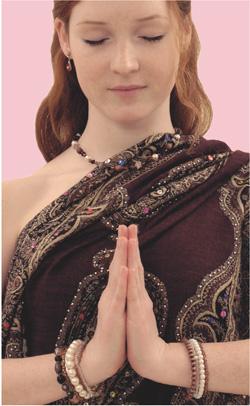
Conscious Gestures Lead Inwards
Mudra means ‘sign’ or ‘seal’. A Mudra is a posture or gesture through which we spontaneously express our feelings or state of consciousness in everyday life. If we feel reverence or esteem, we intuitively fold our hands as if in prayer. Similarly, if we want to pray, we fold our hands for devotion and to collect ourselves by moving our attention inward, to ourselves.

Anjali or prayer Mudra
Mudras and Marmas are closely connected. Awareness expresses itself as a Mudra, and a Mudra – a gesture, a posture that we adopt consciously – in turn creates this state of consciousness. Through a Mudra we can correct disorders in the Marmas, raise their status and strengthen their functioning. If we perform a finger, hand or body posture in a certain way, specific Marmas get ordered, protected, enlivened or calmed. We therefore use Mudras to support and complement a Marma treatment.
Attention improves the effect
To be able to feel the subtle energetic changes in the body consciously, one needs attention, peace and a contemplative attitude. Sit upright, but comfortably. Close your eyes for one moment and breathe deeply. Then perform the appropriate Mudra and without expectation feel what happens in your body or in your consciousness. To get a feeling for the specificity of the energy of a finger gesture you can gently rub your fingers for a moment, as you would if you were testing a piece of silk for quality.
Each Mudra has its grace
Each Mudra expresses a particular state of being and has its own beauty. Feel the specific quality that each Mudra generates in the mind and the subtle changes that take place in your body. Initially it may require a certain degree of patience to feel the flow of energy which a Mudra generates in the body. The first sign that a Mudra is being performed correctly is often the feeling that the nose opens up and breathing becomes freer. Prana begins to flow. But even if you do not feel anything, the Mudra still has its effect and brings about the desired changes.
MUDRAS IN INDIAN TRADITIONAL DANCE
Classical Indian dance dates back to the period of Vedic culture and is an aspect of Gandharva Veda, the knowledge of the healing effect of the sounds and melodies of nature. Gandharva Veda is expressed in singing, with musical instruments or in dance. Mudras play a highly significant role in dance. The feeling and content of the dance – which always tells a story of the great Indian spiritual tradition – finds its expression in the gestures, the specific Mudras of Indian dance.
Understanding the effects of the Mudras
We can understand the effect of various Mudras better if we appreciate their influence on the Marmas, the energy channels, the five elements, the Doshas and Subdoshas, as well as the reflex zones of the hands and feet. In the example of the meditation Mudra (Gyan Mudra, photo 1; page 114), this can be easily illustrated: the tip of the thumb and index finger touch each other, forming a closed circle which incorporates the Kshipra Marma (pages 44–45). The two energy channels of colon and lungs meet in Kshipra, and Pranic energy gathers here as if in a basin, strengthening this Marma. We have already described this confluence of energy pathways, the Sangam, on page 18. Similar effects occur with the other hand Marmas like Talahridaya (pages 46–47), which is incorporated into the circulation of the flow of energy through the opposite positioning of thumb and middle finger (photo 2), or thumb and ring finger.
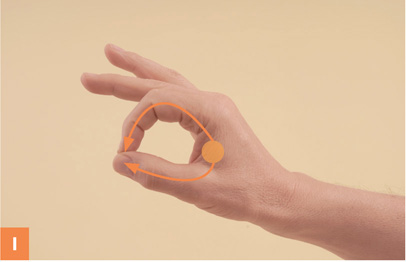
Confluence (Sangam) of the Nadis of colon and lungs in Kshipra
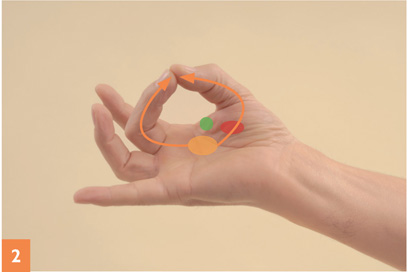
Confluence of the Nadis of circulation and lungs in Talahridaya
We can also understand the effect of a Mudra from the relation of the fingers to the five elements, the Mahabhutas, and the three Doshas (illustration below right). The three Doshas Vata, Pitta and Kapha, derived from the combining of the five elements, manifest respectively on the index, middle and ring fingers. How we form a Mudra with the ‘Dosha fingers’ determines its effect on the three bioregulators and their sub-functions, the Subdoshas. The Prana Subdosha, for example, is located principally in the fingertips and especially in the thumb. Anyone who has strong Prana has great healing power in his or her hands. Prana can be felt as the vibrant energy of the aura that we can perceive when someone’s hand comes closer to our body and penetrates our aura.
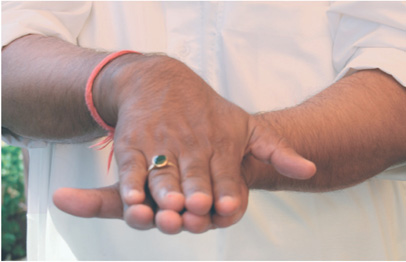
The ‘Fish’ Mudra
Mudras manifest Marmas
Since the hand reflects the whole body in miniature form, we also find here a correspondence to all the other Marmas in the body, comparable to the representation of physical organs on the reflexology zones of the hand. Thus we find a correlation between Adhipati (pages 108–109) and the tip of the thumb. The Marma manifests itself when we put the thumb (which represents totality) together with the index, middle and ring fingers (the representatives of the three Doshas) to form a Mudra, while stretching out the little finger.

The five elements and the three Doshas on the hand
Meditation or Gyan Mudra
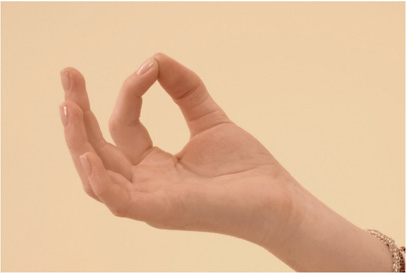
With each hand: Place the tips of the forefinger and thumb together and hold your hands open with the palms facing upwards.
Effect: Supports contemplation and meditation, gives precision in thought and action, helping to find the correct word; strengthens digestive fire (Agni) and gives contentment to the heart (Sadhaka); and helps in respiratory diseases (Udana). Reduces fatigue, especially when the thumb and forefinger are pressed together during inhalation and then relaxed during exhalation.
The ethereal elements of space (Akasha) in the thumb and air (Vayu) in the index finger dominate this Mudra, which is why it raises consciousness and promotes lightness in thinking.
Marmas that are involved and strengthened: Adhipati (tip of the thumb), Kshipra (Sangam of the energy path of index finger and thumb), Kurcha and Kurchashira (contraction of the ball of the thumb).
Practice time: 5–10 minutes twice daily.
Sun or Akash Mudra
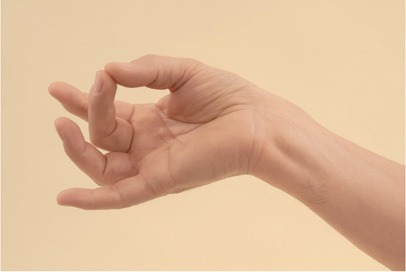
With each hand: Create a circle using your thumb and middle finger and hold the hand open. The other fingers are relaxed.
Effect: Strengthens digestive power (Agni); calms the mind for meditation and improves concentration and contemplation (Prana); eases muscle spasms, especially in the jaw muscles; strengthens Pitta (because the middle finger is the Pitta finger).
Marmas that are involved and strengthened: Sthapani (tip of the thumb), Talahridaya (in the confluence of the energy pathways of the middle finger and thumb), Kurcha and Kurchashira (slight tension in the ball of the thumb).
Practice time: 5–10 minutes twice daily.
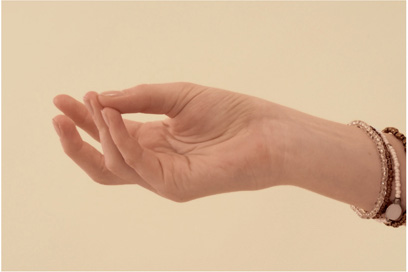
With each hand: Place thumb, little finger and ring finger together to form a circle, letting the other fingers relax and stretch out.
Effect: The energies in the root Chakra and sexual Chakra as well as Guda and Basti Marma are strengthened. This has a rejuvenating effect on the reproductive tissue (Shukra). Eyesight (Alochaka) improves; vitality (Bala, Ojas) and joy in life increase. Guiding Prana to the heavy elements – water (ring finger) and earth (little finger) – has the effect of grounding excess mental activity and settles thinking when there is too much Vata in the nervous system.
Marmas that are involved and strengthened: Talahridaya (in the confluence of the energy pathways of the little finger, ring finger and thumb), Kurcha and Kurchashira (slight tension in the ball of the thumb), Guda and Basti (elements of earth and water) since the little finger and ring finger are involved and the root of the thumb (Guda and Basti) is contracted.
Practice time: 5–10 minutes twice daily.
Mudra for orientation
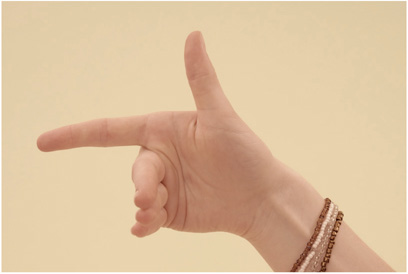
With each hand: Stretch your index finger forward and the thumb up, stretching your other fingers at a right angle. The hand now projects the three directions in space.
Effect: Promotes mental relaxation and concentration (Prana); directs the consciousness (Sadhaka); strengthens the back (Avalambaka); gives vitality (Ojas, Bala); helps you find your way.
Marmas that are involved and strengthened: Ani (index finger stretched, reflexology zone on the back of the finger), Lohitaksha (corresponding area in the stretched crease between the thumb and the forefinger).
Practice time: 5 minutes twice daily.

Grasp the right thumb with your left hand and touch the tip of the left thumb with your right index finger.
Effect: Supports the treatment of thyroid disorders, hoarse voice, throat inflammation and tonsillitis (Udana), digestive weakness and gastrointestinal disorders (Agni); strengthens the reproductive tissue (Shukra) and gives peace to the heart (Sadhaka).
Marmas that are involved and strengthened: Talahridaya and all Kshipras of the left hand, Kurcha (left hand), Kurchashira (right hand).
Practice time: 5–10 minutes twice daily.
Vayu Mudra
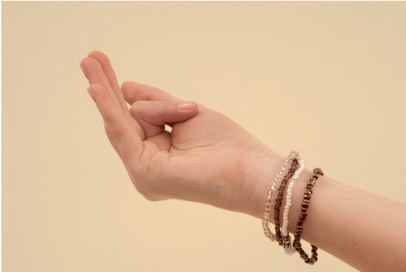
With each hand: Bend your index finger and lay it parallel to the thumb on the ball of the thumb. The other fingers are together and stretched; the hand is opened upward.
Effect: The wind of Vata (air element) sits in the index finger, which is bound to the thumb and is soothed. This Mudra calms Vata beautifully and relaxes it mainly in its root (Apana). It warms the abdomen, strengthens digestive fire and harmonizes peristaltic movement (Samana); strengthens the neck, throat, airways (Udana) and the back (Avalambaka); promotes concentration and meditation (Prana); strengthens eyesight (Alochaka).
Marmas that are involved and strengthened: Kurcha (adjoining finger), Kshipra (integrated by the locking of the index finger and the thumb), Nabhi (hollow of the palm that accumulates Prana).
Practice time: 5–10 minutes twice daily.
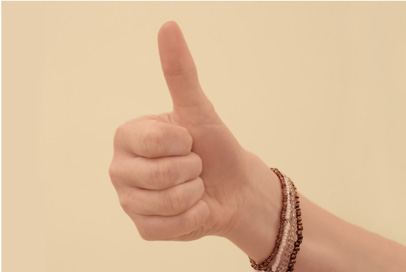
With each hand: Form a very narrow fist and stretch your thumb upwards, as in a ‘thumbs up’ sign.
Effect: Gives strength and enthusiasm (Ojas, Bala), joy in the heart, happiness and confidence (Sadhaka); strengthens the back (Avalambaka); calms anxiety (Prana); provides general warming (Agni).
Marmas that are involved and strengthened: Brihati and Amsaphalaka (upright thumb; equivalents of these Marmas on the back of the thumb), Talahridaya (fingers into the palm), Ani (equivalent on the back of the index finger), Krikatika (equivalent on the back of the stretched distal phalanx of the thumb).
Practice time: 5–10 minutes twice daily.
The fist

With each hand: Form both hands into a loose fist, with thumbs on the outside in front of the middle finger. The fists are in the groin. Sit comfortably upright, close your eyes and feel the energy emanating from the Mudra.
Effect: This is one of the best Mudras for strengthening the root Chakra and the Marmas in the pelvic area and in the groin. The fist awakens vitality and joie de vivre, stimulates the respiratory system, enlivens Prana in the whole organism and increases energy in the throat Chakra.
Marmas that are involved and strengthened: Guda, Lohitaksha, Vitapa, Nabhi and the Marmas of the lower back, especially Kukundara. The vital forces of the lower energy centres are bound and held in the clenched fist. If we put them in the groin, we place them at the root of the body. Shringataka, Nila and Manya will also be strongly affected (on the inside of the distal phalanx of the thumb that touches the back of the middle finger, which has a Pitta quality).
Practice time: 5–10 minutes twice daily.
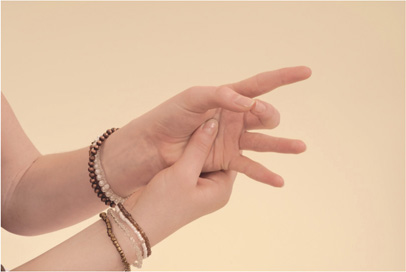
Hold your left hand so that the tip of your right thumb lies in the centre of the left palm. The other fingers lie protectively flat on the back of the hand. The left thumb and middle finger touch each other and form a ring. The fingers that are not involved are stretched and relaxed.
Effect: Gives your heart rest, leads back to the Self (Atma), generally relaxes (Prana, Sadhaka) and regenerates; strengthens the solar plexus (Agni, Samana).
Marmas that are involved and strengthened: Talahridaya (the tip of the thumb corresponding to the brain rests in the heart of the hand: Prana of thinking is brought back to the Self). From Talahridaya all the Marmas of the hand are nourished and strengthened. The middle finger (Pitta) resting on the thumb upholds the dynamic and transformative power of Pitta for regeneration.
Practice time: 5–10 minutes twice daily.
Mudra for self-confidence

Place the tips of the thumb and index fingers so that, when viewed from above, they appear to form a bow and arrow. With the other three fingers bent at a right angle, bring them together so that they touch (see photo above). You can bend the bow by stretching your thumb towards yourself. Your index fingers face forward like an arrow. Make sure that the other three fingers are touching, as explained above. Now move the thumb tips along your sternum, searching for a particularly sensitive point or area. You will feel it when you move slowly up and down in the lower third of the sternum. Place your thumbs here: it is a specific point in the heart Marma where condensed emotions are stored. Sit upright and breathe gently and naturally.
Effect: As the name implies, this Mudra strengthens self-confidence. It touches the feelings of the heart and awakens joy (Sadhaka); it also strengthens the back (Avalambaka).
Marmas that are involved and strengthened: Hridaya (direct contact), Brihati (its counterpart on the back), Amsaphalaka (enlivenment of protective mechanisms on the back).
Practice time: 5–10 minutes twice daily.